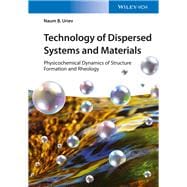
Note: Supplemental materials are not guaranteed with Rental or Used book purchases.
Purchase Benefits
What is included with this book?
Preface IX
Foreword by A.Yu. Tsivadze XI
Foreword by V.M. Prikhod’ko XIII
1 Challenges of Technology of Dispersed Composite Materials 1
References 7
2 Structure Formation in Dispersed Systems and Materials 11
2.1 Types of Contacts between Particles in Dispersed Systems and Materials 11
2.2 Criteria of Formation of Dispersed Structures 14
2.2.1 Characteristic Critical Particle Size 14
2.2.2 Concentration Factor and Strength of Coagulation Structures 18
2.2.3 Time Factor of Strength of Contacts and Dispersed Structures 22
References 28
3 Dynamics of Dispersed Systems in Processes of Formation of Composite Materials 31
3.1 Dynamic State of Dispersed Systems 31
3.2 Dynamics of Contact Interactions in Dispersed Systems 36
3.2.1 Nonequilibrium as the Most Important Feature of Dynamics of Contact Interactions 36
3.2.2 Dynamics of Contact Interactions in Two-Phase Dispersions Containing a Solid Phase and Liquid Dispersion Phase (S–L Systems) 37
3.2.2.1 Consideration of the Electrostatic Component of Disjoining Pressure and Slipping of the Dispersion Medium 37
3.2.2.2 Consideration of Particle Shape Factor 39
3.2.2.3 Role of Elastic Properties of Particles and Structural–Mechanical Barrier Formed by Adsorption Surfactant Layer 41
3.2.3 Elements of Dynamics of Contact Interactions in Highly Dispersed Powders 43
3.2.4 Dynamics of Contact Interactions in Three-Phase Systems 45
References 48
4 Rheology, Vibrorheology, and Superfluidity of Structured Dispersed Systems 51
4.1 Rheology and Vibrorheology of Two-Phase Dispersed Systems 51
4.1.1 Fundamentals of Rheology and Vibrorheology of Two-Phase S–L Systems: Pastes and Suspensions 52
4.1.2 Main Methods and Devices for Measurement of Rheological Properties of S–L Systems 53
4.1.3 Dynamic Loading Modes 59
4.1.4 Full Rheological Flow Curve of Dispersed Systems 60
4.1.5 Rheology and Vibrorheology of Structured Mineral Suspensions 63
4.1.6 Surfactants in Dynamic Processes 71
4.1.7 Vibrorheology and Structure Formation in Bitumen–Mineral Compositions 77
4.1.8 Dynamics of Two-Phase Dispersed L–L Systems: Emulsions 84
4.1.9 Flow and Spreading of Two-Phase S–L Systems over Solid Surfaces 89
4.2 Vibrorheology and Plasticity of Powdered Materials 97
References 103
5 Structure Formation, Rheology, and Vibrorheology of Three-Phase S–L–G Systems 109
5.1 Kinetics Structure Formation Process inThree-Phase Dispersed Systems under Vibration in the Course of Mixing 109
5.2 Structure Formation and Rheology of Three-Phase S–L–G Systems in Compaction Processes 130
References 136
6 Application of Methods of Physicochemical Dynamics in the Technology of Dispersed Systems and Materials 139
6.1 General Principles 139
6.2 Technologies of Dispersed Systems 141
6.2.1 Pipeline Hydrotransport of High-Concentration Suspensions 141
6.2.1.1 Wasteless Technology of Ore Mining with Filling Excavation Cavities by a Hardening Mixture of Highly Dispersed Dead Rock, Cement, Water, and Surfactant Additives 141
6.2.1.2 Technology of Production and Hydrotransport of High-Concentration Coal-Water Slurries 141
6.2.1.3 Technology of Production of Multicomponent Highly Dispersed Aggregation- and Sedimentation-Resistant Dispersions 145
6.2.1.4 Prevention of Consolidation of Hygroscopic Powdered Materials 147
6.3 Dispersed Composition Materials 149
6.3.1 Dispersed Hydration Hardening Materials 149
6.3.2 Abrasive Materials as an Example of High-Filled Highly Dispersed Composites 153
6.3.3 New Type of Composition Material for Road Construction: Asphalt Concrete with Nanodispersed and Polymer Components 155
6.3.4 Effect of Exposure to Vibration of Crystallization Structure, Filled Polymer Composition, and Fibrous Materials 157
References 159
Conclusion 163
Endorsement 165
Appendix 167
Index 175
The New copy of this book will include any supplemental materials advertised. Please check the title of the book to determine if it should include any access cards, study guides, lab manuals, CDs, etc.
The Used, Rental and eBook copies of this book are not guaranteed to include any supplemental materials. Typically, only the book itself is included. This is true even if the title states it includes any access cards, study guides, lab manuals, CDs, etc.